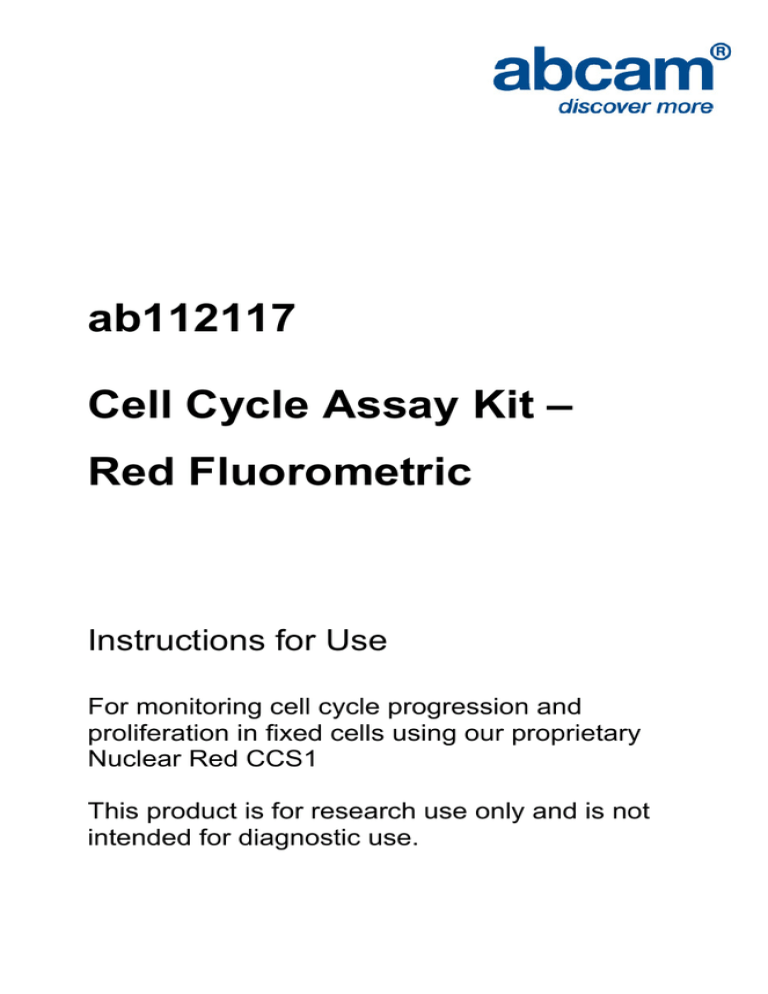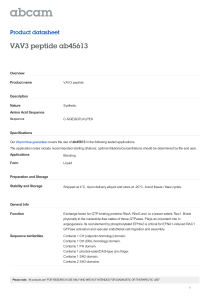ab112117 Cell Cycle Assay Kit – Red Fluorometric Instructions for Use
advertisement

ab112117 Cell Cycle Assay Kit – Red Fluorometric Instructions for Use For monitoring cell cycle progression and proliferation in fixed cells using our proprietary Nuclear Red CCS1 This product is for research use only and is not intended for diagnostic use. 1 Table of Contents 1. Introduction 3 2. Protocol Summary 4 3. Kit Contents 5 4. Storage and Handling 5 5. Assay Protocol 6 6. Data Analysis 9 7. Troubleshooting 10 2 1. Introduction Abcam Cell Cycle assay kits are a set of tools for monitoring cell viability and proliferation. There are a variety of parameters that can be used. In normal cells, DNA density changes depending on whether the cell is growing, dividing, resting, or performing its ordinary functions. The progression of the cell cycle is controlled by a complex interplay among various cell cycle regulators. These regulators activate transcription factors, which bind to DNA and turn on or off the production of proteins that result in cell division. Any misstep in this regulatory cascade causes abnormal cell proliferation which underlies many pathological conditions, such as tumor formation. Potential applications for live-cell studies are in the determination of cellular DNA content and cell cycle distribution for detecting variations in growth patterns, monitoring apoptosis, and evaluating tumor cell behavior and suppressor gene mechanisms. ab112117 is designed to monitor cell cycle progression and proliferation by using our proprietary Nuclear Red CCS1 in fixed cells. The dye passes through a permeabilized membrane and intercalates into cellular DNA. The signal intensity of Red Fluorescence is directly proportional to DNA content after RNA is degraded by RNase provided in the kit. The percentage of cells in a given sample that are in G0/G1, S and G2/M phases, as well as the cells in the sub-G1 phase prior to apoptosis can be monitored with a flow cytometer at Ex/Em = 490/620 nm (FL2 channel). 3 2. Protocol Summary Prepare cells with test compounds at a density of 5 x 105 to 1 x 106 cells/mL Fix cells with 70% Ethanol Add 5 μL of 100X Nuclear Red CCS1 and 5 μL of RNase A into 0.5 mL of cell solution Incubate at room temperature for 30 - 60 minutes Analyze with a flow cytometer Note: Thaw all the kit components to room temperature before starting the experiment. 4 3. Kit Contents Components Amount Component A: 100X Nuclear Red CCS1 1 x 250 µL Component B: 100X RNase A 1 x 250 µL Component C: Assay Buffer 1 x 50 mL 4. Storage and Handling Keep at -20°C. Avoid exposure to light. 5 5. Assay Protocol A. Prepare cells: 1. Treat cells with test compounds for a desired period of time to induce apoptosis or other cell cycle functions. 2. For each sample, prepare cells in 0.5 mL PBS at a density of 5x105 to 1x106 cells/mL. Note 1: Each cell line should be evaluated on an individual basis to determine the optimal cell density for apoptosis induction. Note 2: For Adherent Cells - The cells are trypsinized, suspended in 10% FBS medium, centrifuged (1000 rpm, 5 min), and the pellets are re-suspended in PBS. For Suspension Cells - The cells are centrifuged (1000 rpm, 5 min), and the pellets suspended in PBS (1 mL). 6 B. Fix the cells with 70% Ethanol Pipette 0.5 mL cell suspension (from section A, step 2) into 1.2 mL absolute Ethanol (final concentration approx. 70%). Incubate cells on ice for at least 2 hours (or overnight at -20°C). Cells can be stored at -20 °C for up to 2 years before staining. Note 1: Ethanol is commonly used for fixation after cell surface antigens were stained with monoclonal antibodies, while methanol is commonly used for fixation after intracellular antigens were stained with monoclonal antibodies. Note 2: In this procedure whole cells are fixed and analyzed. Because the entire cell mass is still present, the use of RNase is typically included to eliminate any double-stranded RNA. Despite the fact that whole cells are being analyzed, attempts to detect some intracellular antigens in conjunction with DNA may fail because the proteins leak out of the permeabilized cell (e.g. green fluorescent protein). In these cases a brief pre-fixation (10 minutes at 4-6 °C) with 1% paraformaldehyde in PBS before the alcohol fixation will help retain the proteins in the cell. 7 C. Stain the cells with Nuclear Red CCS1: 1. Pellet the cells at 1000 rpm for 5 minutes (from step B), and wash cells at least once with cold PBS. 2. Suspend the pellet in 0.5 mL of Assay buffer (Component C), and add 5 μL of 100X Nuclear Red CCS1 (Component A) and 5 μL of 100X RNase A (Component B). Incubate the cells at room temperature for 30 to 60 minutes. Note: The appropriate incubation time depends on the individual cell type and cell concentration used. Optimize the incubation time for each experiment 3. Optional: Centrifuge the cells at 1000 rpm for 5 minutes, and re-suspend cells in 0.5 mL of assay buffer (Component C) or buffer of your choice. 4. Monitor the fluorescence intensity with a flow cytometer using the FL2 channel (Ex/Em = 490/620 nm). Gate on the cells of interest, excluding debris. 8 6. Data Analysis Figure 1. DNA profile in growing Jurkat cells. Jurkat cells were dyeloaded with Nuclear Red CCS1 and RNase A for 30 minutes. The fluorescence intensity of Nuclear Red CCS1 was measured with a flow cytometer using the FL2 channel. 9 7. Troubleshooting Problem Reason Solution Assay not working Assay buffer at wrong temperature Assay buffer must not be chilled - needs to be at RT Protocol step missed Plate read at incorrect wavelength Unsuitable microtiter plate for assay Unexpected results Re-read and follow the protocol exactly Ensure you are using appropriate reader and filter settings (refer to datasheet) Fluorescence: Black plates (clear bottoms); Luminescence: White plates; Colorimetry: Clear plates. If critical, datasheet will indicate whether to use flat- or U-shaped wells Measured at wrong wavelength Use appropriate reader and filter settings described in datasheet Samples contain impeding substances Unsuitable sample type Sample readings are outside linear range Troubleshoot and also consider deproteinizing samples Use recommended samples types as listed on the datasheet Concentrate/ dilute samples to be in linear range 10 Problem Reason Solution Samples with inconsistent readings Unsuitable sample type Refer to datasheet for details about incompatible samples Use the assay buffer provided (or refer to datasheet for instructions) Use the 10kDa spin column (ab93349) or Deproteinizing sample preparation kit (ab93299) Increase sonication time/ number of strokes with the Dounce homogenizer Aliquot samples to reduce the number of freeze-thaw cycles Troubleshoot and also consider deproteinizing samples Use freshly made samples and store at recommended temperature until use Wait for components to thaw completely and gently mix prior use Always check expiry date and store kit components as recommended on the datasheet Samples prepared in the wrong buffer Samples not deproteinized (if indicated on datasheet) Cell/ tissue samples not sufficiently homogenized Too many freezethaw cycles Samples contain impeding substances Samples are too old or incorrectly stored Lower/ Higher readings in samples and standards Not fully thawed kit components Out-of-date kit or incorrectly stored reagents Reagents sitting for extended periods on ice Incorrect incubation time/ temperature Incorrect amounts used Try to prepare a fresh reaction mix prior to each use Refer to datasheet for recommended incubation time and/ or temperature Check pipette is calibrated correctly (always use smallest volume pipette that can pipette entire volume) 11 Standard curve is not linear Not fully thawed kit components Pipetting errors when setting up the standard curve Incorrect pipetting when preparing the reaction mix Air bubbles in wells Concentration of standard stock incorrect Errors in standard curve calculations Use of other reagents than those provided with the kit Wait for components to thaw completely and gently mix prior use Try not to pipette too small volumes Always prepare a master mix Air bubbles will interfere with readings; try to avoid producing air bubbles and always remove bubbles prior to reading plates Recheck datasheet for recommended concentrations of standard stocks Refer to datasheet and re-check the calculations Use fresh components from the same kit For further technical questions please do not hesitate to contact us by email (technical@abcam.com) or phone (select “contact us” on www.abcam.com for the phone number for your region). 12 13 14 UK, EU and ROW Email: technical@abcam.com Tel: +44 (0)1223 696000 www.abcam.com US, Canada and Latin America Email: us.technical@abcam.com Tel: 888-77-ABCAM (22226) www.abcam.com China and Asia Pacific Email: hk.technical@abcam.com Tel: 108008523689 (中國聯通) www.abcam.cn Japan Email: technical@abcam.co.jp Tel: +81-(0)3-6231-0940 www.abcam.co.jp 15 Copyright © 2012 Abcam, All Rights Reserved. The Abcam logo is a registered trademark. All information / detail is correct at time of going to print.

![Anti-FAT antibody [Fat1-3D7/1] ab14381 Product datasheet Overview Product name](http://s2.studylib.net/store/data/012096519_1-dc4c5ceaa7bf942624e70004842e84cc-300x300.png)
